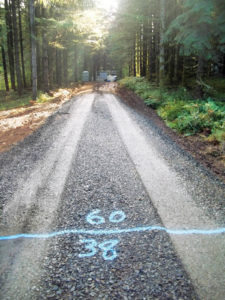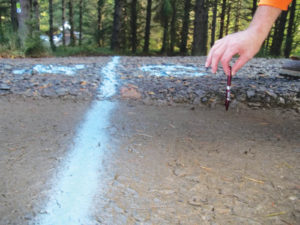
Introduction
During a 2014 logging industry event in the Pacific Northwest, geogrid was used to reinforce portions of a heavily travelled logging road. The demonstration was conducted during the Pacific Logging Congress, 7th In the Woods, held in Molalla, Ore.
An aggregate haul road was constructed to demonstrate the difference of an unreinforced road section vs. a section reinforced with geogrid. The result showed that the reduced use of aggregate with geogrid minimized rutting caused by fully loaded logging trucks.
Hands-on venue
Port Blakely Tree Farms was the host of this logging show. Conducted every four years, this “live in the woods” event is part of the Pacific Logging Congress and provides a hands-on venue where growers, loggers, and regulators come together to share state-of-the-art practices and technologies for the responsible and economical harvest of timber. Show attendees witness an assortment of live logging activities, all utilizing the latest, most advanced equipment, technology, and environmentally responsible methods.
“Aggregate surface haul roads are used to expedite transportation of timber as well as to prevent soil loss and minimize erosion,” said Bob Klein, executive vice president with Advanced Drainage Systems Inc. (ADS). “A typical haul road generally requires about 14 to16 inches of quality aggregate, about 60 cubic yards for every 100 feet of haul road. Suitable aggregates, however, are often some distance away. The cost of buying and transporting this amount of aggregate can quickly surpass any financial gains brought by expedited transportation of the timber. But with the addition of the proper geogrid, the amount of needed aggregate is greatly reduced, making it economically practical to build a road that will last.”

200-ft. unpaved road
As part of the show, a 200-foot-long haul road was constructed. Half of the road was constructed as a conventional logging road with 16 inches of compacted aggregate over the native subgrade. The other half was constructed with 8 inches of compacted aggregate placed over the geogrid, which had been unrolled over the native subgrade, and then 500 gallons of water was pumped over the surface and allowed to saturate.
Klein noted that the geogrids were able to withstand stress in two directions and their apertures are more evenly dimensioned. For the demonstration, a fully-loaded tractor trailer logging truck travelled back and forth during several days over both sections of the roadway.
“The reinforcement benefit of the geogrid with its positive mechanical interlock was quickly evident,” Klein said. “Ruts began forming in the unreinforced sections and got deeper and deeper with each pass. Only minimal rutting was witnessed in the reinforced section. With just 8 inches of compacted aggregate, the reinforced section proved stronger than the unreinforced section that had twice the amount of aggregate. Using the geogrid reduced aggregate use by 50%.”
 Klein explained that the geogrids are designed for soil stabilization, base reinforcement, and subgrade improvement used in road reinforcement, parking lots, and airport aprons and runways where stresses are in two directions. These particular geogrids were produced from polypropylene (PP) using punched-and-drawn technology and are available in six versions in a variety of widths and lengths.
Klein explained that the geogrids are designed for soil stabilization, base reinforcement, and subgrade improvement used in road reinforcement, parking lots, and airport aprons and runways where stresses are in two directions. These particular geogrids were produced from polypropylene (PP) using punched-and-drawn technology and are available in six versions in a variety of widths and lengths.
Klein noted that the engineered grid pattern of geogrid products is the key to their load-bearing strength and support. He continued: “Interlocking this pattern with fill, whether it is soil, gravel, or rock, produces a superior load transfer that provides security for a project, whether it is for a road or for base reinforcement and soil stabilization.”
 TEXTILES.ORG
TEXTILES.ORG


